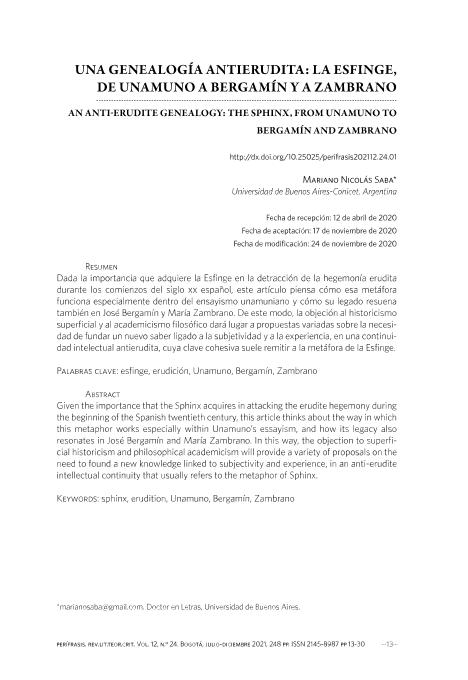Artículo
Dada la importancia que adquiere la Esfinge en la detracción de la hegemonía erudita durante los comienzos del siglo xx español, este artículo piensa cómo esa metáfora funciona especialmente dentro del ensayismo unamuniano y cómo su legado resuena también en José Bergamín y María Zambrano. De este modo, la objeción al historicismo superficial y al academicismo filosófico dará lugar a propuestas variadas sobre la necesidad de fundar un nuevo saber ligado a la subjetividad y a la experiencia, en una continuidad intelectual antierudita, cuya clave cohesiva suele remitir a la metáfora de la Esfinge. Given the importance that the Sphinx acquires in attacking the erudite hegemony during the beginning of the Spanish twentieth century, this article thinks about the way in which this metaphor works especially within Unamuno’s essayism, and how its legacy also resonates in José Bergamín and María Zambrano. In this way, the objection to superficial historicism and philosophical academicism will provide a variety of proposals on the need to found a new knowledge linked to subjectivity and experience, in an anti-erudite intellectual continuity that usually refers to the metaphor of Sphinx.
Una genealogía anti-erudita: la Esfinge, de Unamuno a Bergamín y a Zambrano
Título:
An anti-erudite genealogy: the Sphinx, from Unamuno to Bergamín and Zambrano
Fecha de publicación:
07/2021
Editorial:
Universidad de los Andes. Facultad de Artes y Humanidades. Departamento de Humanidades y Literatura
Revista:
Perífrasis
ISSN:
2145-8987
e-ISSN:
2145-9045
Idioma:
Español
Tipo de recurso:
Artículo publicado
Clasificación temática:
Resumen
Palabras clave:
ESFINGE
,
UNAMUNO
,
ZAMBRANO
,
BERGAMÍN
,
ERUDICIÓN
Archivos asociados
Licencia
Identificadores
Colecciones
Articulos(SEDE CENTRAL)
Articulos de SEDE CENTRAL
Articulos de SEDE CENTRAL
Citación
Saba, Mariano Nicolás; Una genealogía anti-erudita: la Esfinge, de Unamuno a Bergamín y a Zambrano; Universidad de los Andes. Facultad de Artes y Humanidades. Departamento de Humanidades y Literatura; Perífrasis; 12; 24; 7-2021; 13-30
Compartir
Altmétricas




